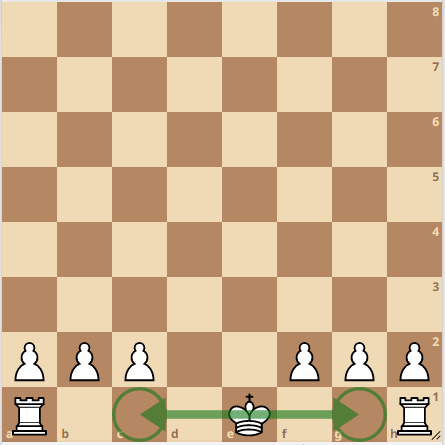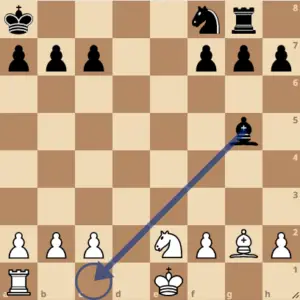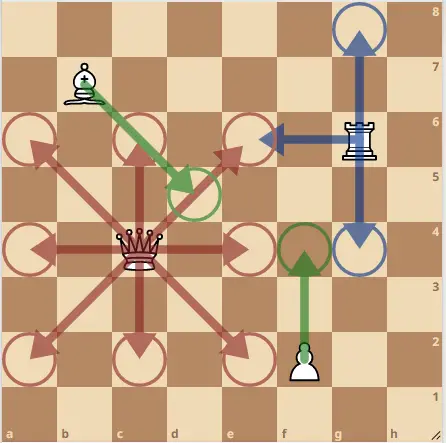Having a firm understanding of how the chess pieces move is important if you want to know how to play chess well. Out of all the pieces on the chess board, the king is the most valuable piece, as checkmating the king ends the game. Therefore, you need to be able to understand the movement of the king so that you can safeguard it from attacks.
One common question that many beginners ask is “Can the king move 2 steps in chess?” In this article, we answer that question and explain how the king mvoes. Here is what you should know:
Can The King Move 2 Steps In Chess?
The king can move two steps closer to the rook when castling. This special move can only be done once in the game and on no other move besides castling.
The king can move 2 steps to the right or 2 steps to the left depending on the type of castling being performed. For example, the white king can move 2 steps to the right when castling kingside, or 2 steps to the left when castling queenside.
The white king can move 2 steps to the right or left when castling

For black, the board is alternated. The black king moves 2 steps to the left when castling kingside, or 2 steps to the right when castling queenside.

Note that the rook has to jump over and land next to the king for castling to be complete. This means you cannot simply move the king 2 steps without the rook being involved. Castling is the only time you can move two pieces on one move.
The rook has to jump over and land next to the king for castling to complete

When Can’t The King Move 2 Steps?
The king cannot move 2 steps during castling if:
1. There are pieces between the path of the king and rook: This could include your own pieces or your opponent’s pieces. You will have to remove your pieces from the backrank so that you can move your king 2 steps to castle.
2. The path to which the king castles is controlled by enemy pieces: A long ranged piece such as your opponent’s bishop can block the path to which the king travels. It usually slices through the board, cutting off the connection between the rook and king.
The black bishop prevents the white king from moving two steps to the left

3. The king cannot move 2 steps if it already moved in the game.
4. The king cannot move 2 steps towards a rook that has already moved: This means if white wants to castle kingside, but his h1 rook has already move, then castling is illegal.
5. The king cannot move 2 squares if it is in check. The player would have to block the check with one of his pieces, move his king away from the check, or remove the piece delivering check by means of capturing it.
You can find out more about castling here: When to castle in chess?
How Many Steps Can The King Move?
The king can only move 1 step at a time, and 2 steps when castling. It can move to any of its neighboring squares. This means it can move up, down, sideways or diagonally one square.
The following game shows how the two kings move across the chess board. Click the arrow to go through the game.
The power of the king is small when compared to major pieces like the rook and queen. It can’t move from one end of the board to the other as it would like. Nevertheless, this is a good thing because the chess game would go on for a very long time if the king was given such power.
If the king was to be given a value, it would be worth 4 points which is greater than that of a bishop or a knight.
However, because checkmating the king marks the end of the game, then the king is perhaps worth infinite amount of points. The king is the most important piece on the board and should be protected at all cost.
You protect the king by castling, or using your own pieces and pawns to create a shelter for the king. Prioritizing king safety is crucial in the middlegame. On the other hand, king safety becomes less of a priority in the endgame as most pieces are traded off. The role of the king in the endgame is to get as active as possible and help the pawns up the board to promote to a queen.
Which Other Pieces Can Move 2 Steps?
Every piece including the pawns can move 2 steps, with the excpetion of the knight. However the direction at which they move varies.
For example, the pawns can move 2 steps forward on their first move. The Queen can move any number of squares, in any direction, in a straight line. This means it can move 2 steps if it desires.
The Bishops move diagonally any number of squares. It can move 2 steps diagonally forward if it likes.
Lastly are the rooks. Rooks move up, down and sideways any number of squares. This also means that the rook can move 2 steps forward, backward or sideways.
The knight is the only piece than cannot move 2 steps. The knight move 2 squares like a rook and then one square at a right angle (totaling 3 squares).
The bishop, queen rook and pawn can move 2 steps

Final Verdict
The king can indeed move 2 steps in chess, but only when castling. The purpose of this move is to safeguard your king and prevent it from being attacked in the center of the board. Once you’ve castled, your king is usually locked behind your pawns which serve as a shelter for the king.
Keep in mind that the king cannot move 2 steps if there are pieces between the path of the king and rook. This path should not be controlled by your opponent’s pieces (particularly the squares to which the king moves), nor can the king move 2 steps to castle if it is in check. To learn more about castling out of check, click here.


